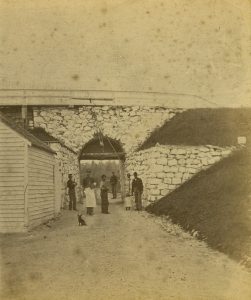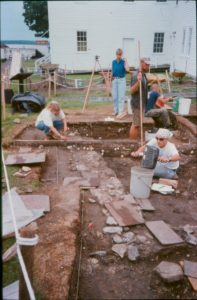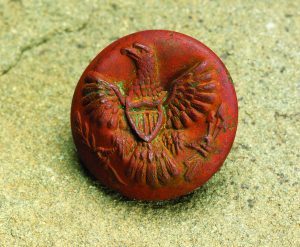
One of the “missing” buildings at Fort Mackinac is the blacksmith shop. Military records, maps, and even a photograph indicate that a series of three blacksmith shops was present just inside the north sally port for most of the fort’s military service.
An archaeological project to search for their remains was undertaken as part of the centennial celebration of the Mackinac Island State Park Commission in 1995 and the bicentennial of the arrival of American troops in 1996. The excavations were carried out as University of South Florida [USF] field schools under the direction of Dr. Roger T. Grange, Jr. Ford Motor Company sponsored the project. Information for this post was drawn from Dr. Grange’s unpublished reports and Sheila Stewart’s USF master’s thesis on the third blacksmith shop.
Although the services of a blacksmith would have been required during the construction of Fort Mackinac, the location of his shop is not known. Based on the dates and nationalities of the military buttons excavated during this project, it appears that the first shop near the sally port was built by the Americans in the late 1790s. The remains of the first shop, especially the forge base, were preserved well enough to determine the basic layout of the shop. In addition to making and repairing tools and hardware for the construction and maintenance of fort buildings, and keeping arms in good repair, the blacksmith would have provided services to the Indian Department. The services of a blacksmith were commonly included in treaties with Native American nations.

By 1828 the blacksmith shop was in poor condition, so it was dismantled and rebuilt in approximately the same location. Of the three shops, the second had the most substantial foundation, stone walls which are preserved below the fort’s sod today.
The second blacksmith shop was destroyed by a major fire, which started in the nearby bakehouse, in 1858. The clearing of the fire rubble removed most of the artifacts and features from this era.
Almost immediately after the fire, a third blacksmith shop was built in the same area. It sat on cornerstones, two of which survived, and its dimensions were partially determined archaeologically by the dripline in the gravel indicating the roofline. By analyzing artifact distribution and soil chemistry, Stewart was able to determine the shop layout, including the forge area, anvil mold, work area, and coal and metal storage areas. The artifacts from the third shop also reflect how the role of the blacksmith changed with the Industrial Revolution. By the 1870s the U.S. Army was using mass-produced weapons with interchangeable parts, so gun repair was no longer a major component of a military smith’s work. Hand-forged tools and hardware were replaced by cast iron and steel. Across the continent, not just in military garrisons, farrier work (shoeing horses) became the main task of blacksmiths. In 1875, this change led to a new blacksmith shop being built near the fort stables, which were located in what is now Marquette Park. The shop in the fort was used for storage for a few years but was dismantled by 1879.

Today there are no visible remains of the blacksmith shops within the walls of Fort Mackinac, but the stone foundations lie below the grass just outside the barracks restrooms. Stop and imagine the sights, sounds, and smells of the blacksmith the next time you visit. Fort Mackinac opens for the season on May 3, 2022.









